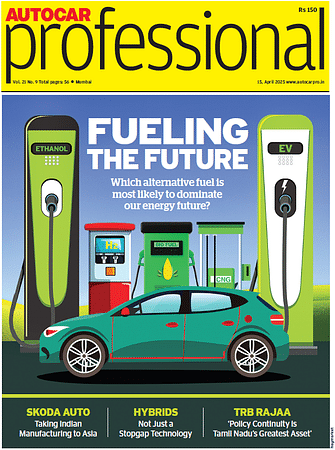'India Can Become a Major Pillar for Us' - Marquardt Group
Björn Twiehaus, CEO of Marquardt Group, and Vishal Narvekar, the company's India GM, share their outlook on the Indian market and their expectations from prospective partners here.
India, the world’s third largest automotive market, is witnessing action across vehicle categories, and German mechatronics specialist Marquardt Group is keen to make the most of this opportunity. Outside the passenger vehicle segment–which contributes the most to the group's India sales–it has spotted opportunities in the two- and three-wheeler, truck, and construction equipment categories, says Chief Executive Officer Björn Twiehaus.
The company is one of the world’s prominent manufacturers of switches, passive keyless entry systems and battery management systems. According to him, the group expects its India business to grow faster than those of all other regions, and in March, it opened a new production plant in Talegaon near Pune to ensure they have enough capacity to cater to demand.
By 2030, it expects its annual turnover from the India business to grow 10 times, from the current 40 million euro turnover. Here are the edited excerpts of the conversation with Twiehaus and Marquardt India’s General Manager, Vishal Narvekar. The two shared insights on opportunities in India, sustainable mobility solutions, their product portfolio, and geopolitical uncertainty.
How much does the India market contribute to your business at a group level? Where do you see it heading in terms of growth by 2030?
Twiehaus: India has the potential to become a major pillar of our group business in the future. At the moment, our turnover from this market is 40 million euros. It’s small compared to the 1.4 billion euro turnover on a group level. But the Indian market is growing and we are prepared to capitalise on it. With the opening of our new production facility in Talegaon, now we have enough capacity to cater to demand for our parts in future.
Outside the passenger vehicle segment, we also see opportunities in the two and three-wheelers, trucks, and construction equipment categories in the country. There is huge potential in these segments as well as in nonautomotive segments. So we are optimistic about our prospects. We expect our India business to grow faster than all other regions. We are targeting a turnover of 400 million euro per year with good profitability by 2030.
What makes you confident in your ability to deliver such strong growth over the next five years?
Twiehaus: There are two reasons why we are confident of delivering such sharp growth. First, confidence in the people that they can handle end-to-end. Our team here is motivated, capable and well prepared. Plus they have the prior experience of handling a smaller facility in Mumbai. And the second reason is that we have tie ups with wellknown automotive companies from India.
Currently, we provide parts to Mahindra & Mahindra, Maruti Suzuki India, Tata Motors, Hyundai Motor, Kia, TVS Motor Co, Daimler, and Stellantis. So we have established business relationships. It's not a greenfield activity that we have to start opening the doors. Now it's much easier to penetrate further product lines with these customers because they are convinced with the quality and the delivery status.
Among vehicle segments, which is the biggest contributor to your sales in India? How much of your business comes from internal combustion engine powered vehicles and electric vehicles?
Narvekar: The passenger vehicle segment is the biggest contributor to sales in India. In this segment, 10-15% of our business comes from EVs and the rest from the ICE segment. Among electric vehicle manufactures, we provide parts to Tata Motors and Mahindra. Going forward, with the launch of more EVs, and a shift in sales trend, we expect the EV contribution to grow.
Twiehaus: The EV segment will support the company’s future growth, but we are not dependent on it. Regardless of powertrain and fuel, whether hydrogen, electric or ICE, all vehicles will require switches, human interface solutions, and entry and authorisation solutions. We provide technologies and solutions which support all kinds of powertrains.
In search of sustainable mobility solutions, automakers are exploring different fuels and powertrains. What is your take on this?
Twiehaus: For passenger cars, and two and three-wheelers, I think electrification is clearly the way forward. Globally, there is continuous growth in EV sales. If you look at China, it's already done, and I think the same is coming for India and other countries. In the truck segment, there has been some electrification, but it's not efficient in terms of the driving range they offer.
Therefore, we may see more hydrogen and synthetic gasoline technologies in the truck segment. And for us, this means we have to observe, discuss with customers and find solutions for their problems. We have to be agile. In these diverse markets, we have to find the best modular approaches to cope with the complexity.
What are the lessons you learnt from the operation of your plant in Mumbai? How have these lessons been incorporated in the new facility?
Twiehaus: The one thing we learned is that we will be much stronger in the region if we have both research and development and production units in close proximity. We can support our customers with end-to-end solutions. Most of our customers are either building or have plants in Pune. Other than developing for the region, now we are also developing for global projects from India. So, they are taking over software development and validation. And we can extend that business as well.
What was the thinking behind selecting Talegaon in Pune to set up a new production base?
Narvekar: There were multiple reasons to select Talegaon as the base. The first reason is that we wanted to be closer to our research and development centre, which is in Pune. When you look at product development and production, they are two processes which are interconnected, and both teams need to work together. The second reason was to come closer to the suppliers and customers both. As you know, Chakan is the base for suppliers as well as major original equipment manufacturers. The third objective was to attract the right talent. Mumbai is not a hub of auto component makers, so sometimes it becomes difficult to get people with the right skills.
With the opening of the Talegaon facility, by how much has your manufacturing capacity gone up in India?
Narvekar: For this year, it would be just 20% higher than the Mumbai plant capacity. But there is scope to up the capacity by 10 times from the current levels to cater to future demand. There is scope for brownfield expansion on this plot as and when the need arises. If you look at the current shop floor, we have not even occupied half of it yet.
What are your export plans?
Narvekar: We are already exporting parts from our Mumbai plant, and we will continue to do that from the new facility as well. We have been able to meet the global quality standard. Currently, we supply parts to South Korea and Europe. Nearly 12% of our sales come from exports. With the new facility, there is scope to increase exports further. But it will also depend on the customer contracts. Our primary focus is to cater to domestic demand.
Twiehaus: I would say we are open to supporting our global needs from India, but the primary reason why we have invested so much here is to have a plant for this region.
The geopolitical tensions have increased in recent times, with a threat of tariff war looming. Do you expect any challenges on the supply front in the near future? And how do you plan to cope with this?
Twiehaus: There are challenges, but I wish everybody cools down a little bit and we work together again globally. Because in the end, that is the best for all of us. If the situation worsens then it would impact everyone directly or indirectly. At Marquardt, we cannot steer the situation, so we have to observe, adjust and consider. But in the end, we are entrepreneurs. We have to search for solutions, and this is what we are looking for, especially in India.
Narvekar: In terms of parts supply, close to 80% of our mechanical components are procured locally and 20% are imported due to specific critical reasons. When it comes to e-components, we still need to import them. So, that's how the distribution is.
Have you seen any interest from Indian suppliers for providing parts for technology shown in Demo Car 2.0?
Twiehaus: In the end, we need alternatives from India for local and global technological requirements. Decoupling is something our customers are looking for. Many Indian suppliers visited the Demo Car 2.0 booth and started a discussion with me about how they can support us and how we can work together. So yes, we are looking for partnerships also in India. For me, it is important to have the Indian speed and innovation spirit. But at the same time, we are looking for discipline and quality which is up to German standards. There are partners here who deliver on time, with the right quality and quantity.
Are you looking for tie ups with charge point operators to provide your robotic charging solutions for EVs?
Twiehaus: There is no concrete plan as of now. We want to support companies who are looking for technical solutions in this space, but cars will also need to be equipped with communication technology. It's more than just a robot charging a vehicle. If you want to have automated charging, there needs to be communication between the car and robot.
So that when a car comes to the charging station the robot can charge, and when it is finished the car should move away so that the next car can come. So there is more to it if you really think about automated charging than just to enter the plug via a robot. It's an ecosystem which we want to support, and are looking for partners who would like to work with us on those technologies.
RELATED ARTICLES
Luxury Car Market to Slow in 2025: Mercedes-Benz Sees Flattish Numbers
In Jan to March of 2025, the market may witness its slowest growth since COVID-19, and if the weakness continues, the se...
‘We Must Have More Women Leaders in the Auto Sector:’ Anjali Rattan
The chairperson of the New Delhi-headquartered RattanIndia Enterprises believes that with their multi-tasking nature, wo...
‘SDVs open an avenue for women to be more inclusive in the auto industry’: DTICI’s Angelin Mary GP
Angelin Mary GP – Vice-President, Vehicle Software, Daimler Truck Innovation Centre India (DTICI) – revisits her journey...






 By Darshan Nakhwa
By Darshan Nakhwa
 06 Apr 2025
06 Apr 2025
 2656 Views
2656 Views





 Prerna Lidhoo
Prerna Lidhoo




